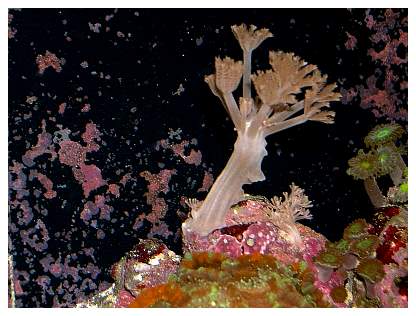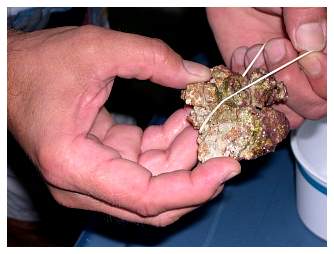|
Propagation of Xenia sp.
I've been fragmenting Xenia sp. for many years, but to thoroughly prepare myself for this recent project, a visit to my friend Brian Greene was in order. Brian owns and runs Greene Mariculture. In addition to several other corals he propagates, he easily has several hundred colonies of Xenia in his facility. When asked his preferred method of fragmenting them, he replied that he doesn't fragment Xenia because it's neither cost nor time effective - he simply allows them to self-propagate. His preferred method is to put a few colonies into a tank with rubble and allow them to spread naturally. In his Book of Coral Propagation, Anthony Calfo refers to this technique as "natural settlement."
|
Mother colonies of Xenia at Greene Mariculture. |
|
At first glance it may appear that the glass is covered with coralline algae, but it's actually Xenia colonies that have spread to the tank’s walls. More about fragmenting Xenia on the tank's sidewalls will be discussed later. |
 |
If you look closely at the above picture, you'll see that the larger Xenia has a couple of “nubs” on the right side of its trunk. This Xenia, with no interference or action by me, leaned over in my tank and temporarily attached itself to the live rock at the points that are now “nubs.” As you can see, the tissue it left behind has grown and created a clone of itself. This technique can also be used with some modifications in the home aquarium to propagate all species of Xenia. Pieces of rubble can be placed around a colony and the Xenia can be allowed to attach to them naturally. Once it's attached to the rubble, the stalk can be cut between the base and the rubble with a razor blade, and the propagated colony on the rubble can be removed. The remaining tissue left behind will re-grow into a new colony. In addition to being an excellent way to propagate Xenia, it's also effective for preventing Xenia from spreading excessively and overgrowing other corals. In my experience the species of Xenia commonly known as Red Sea and/or Pom Pom Xenia, is best propagated using this technique because it's very difficult to handle once it's been disturbed.
Allowing a coral such as Xenia to self-propagate is the preferred method of fragmenting it, but in some cases the aquarist must step in and lend a helping hand. In the case of Xenia growing along the sides of a tank, they'll eventually migrate to the top of the tank and need to be removed.
|
This colony has climbed up the overflow and won't survive long in its current situation. |
In the above photos I'm using a plastic credit card to carefully peel away the colony from the acrylic overflow (finally, a use for those fake credit cards you get in the mail!). I used the plastic card so I wouldn't scratch the acrylic while removing the Xenia. If the surface is glass, a single-edged razor blade is an excellent tool for removing the colony. A colony attached to substrate is removed in a similar manner, although you'll actually be cutting the colony at its base with a razor blade.
 |
 |
The easiest way to attach the fragment is to rubberband its foot to a piece of live rock (photos above). I buy bags of mixed sized rubberbands so the appropriate size can be used. You want the rubberband to provide a snug fit, but not to be so tight that it will crush or sever the colony. Positioning the coral’s base in a small depression in the rock helps to relieve pressure on the coral and allow it to attach more quickly. I've been told (Brian Greene, pers comm.) that colonies removed cleanly from their attachment on glass can be super-glued directly to the rock, although I haven't tried this technique myself.
This technique of rubberbanding Xenia comes with a disclaimer. Some species of Xenia tolerate this method very well and are very easy to rubberband to a piece of rubble. Other species are not so hardy and dissolve into a pile of mush when handled like this. Generally speaking, attaching these species is like trying to nail jello to a tree. If you're going to attempt this method, then start out by cutting only one colony to learn how your Xenia reacts to this type of propagation technique.
|
After fragmenting your prized Xenia you'll probably look at the sorry looking specimen that remains and wonder what you did. Be patient, it will recover. |
When I first became involved with the reef hobby about 10 years ago, I was very fortunate to buy a large colony of Xenia sp. from an aquarist getting out of the hobby. I say fortunate because, at that time, Xenia was considered a rare coral. I suspect that it was rare because it was a poor shipper with low survival rates. In addition there were few sources of information about propagating corals, so the owners of colonies weren't willing to attempt to propagate their "rare" corals for fear of destroying the entire colony. I made a veritable cottage industry of fragmenting my Xenia and making the rounds of local fish stores to trade for the aquarium supplies/livestock I wanted. Within a couple of years the market was flooded, and I couldn't give away my Xenia frags - things change quickly in this hobby!
During the process of fragmenting Xenia one day, I felt an itch in the area on the left side of my mouth. Thinking my left hand was "clean"I made the mistake of scratching that itch. I quickly realized that there was mucous from the coral on my hand. Anyone who has removed Xenia from the water knows that it smells terrible, and I can tell you it's a fact that it tastes even worse than it smells. I managed to maintain my composure, resisted the urge to regurgitate and finished mounting the fragmented Xenia. After awhile my lip began to tingle and became numb. Within an hour and a half the entire left side of my mouth was numb and my tongue began to feel "thick" - for lack of a better word. While collecting information about Xenia for the doctors in anticipation of an upcoming trip to the emergency room, the numbness began to subside. After about another hour my mouth was back to normal - but I wasn't! I learned a valuable lesson about the corals we keep and the unknown dangers we’re likely to encounter. I now clean everything that comes into contact with corals with very hot water, and wash my hands with hot soapy water after fragmenting.
Happy fragging, and be careful out there!
If you have any questions
about this article, please visit my author forum
on Reef Central.
|

